Vertigo
What Does Vertigo Mean?
Vertigo is a disorienting sensation of imbalance, often accompanied by a feeling that one’s surroundings are spinning or moving.
You could have vertigo or feeling that everything is moving when you have dizzy spells. An inner ear problem is frequently the cause of vertigo. Depending on how strong the sensation is, it could be hard to stay balanced and go about your everyday activities.
Symptoms of vertigo may come on suddenly and last only a few seconds, or they can continue for a very long time. Severe vertigo can cause symptoms that are difficult to manage and last for several days, making it challenging to perform regular tasks.
What does it like to be feeling dizzy?
Vertigo, the feeling that you are spinning while still or that everything around you is moving, can be relieved with exercise. Tiny calcium carbonate crystals that enter the semicircular canal of your inner ear from another location cause this illness.
Vertigo is an unexpected, uncontrolled dizziness that is caused by no movement. Your brain receives this information from your senses. sensation your body is unstable while being balanced. Vertigo is a symptom of an underlying ailment rather than a diagnosis in and of itself. It could come from several sources.
Vertigo is not a rare condition; many people experience it regularly. Still, things might turn around. The symptoms of this illness include dizziness and instability. Together with medical attention, targeted exercise can help manage vertigo because it is a symptom of numerous disorders rather than a particular illness.
What Are the Causes of Vertigo?
There are various causes of vertigo. The condition makes people who get it feel lightheaded and as though their brains are constantly spinning. There are two different kinds of vertigo: central vertigo and peripheral vertigo. The former occurs in cases of brain disorders. However, the latter is linked with an inner ear problem.
Benign paroxysmal positional vertigo (BPPV):
- Among those who have the condition, this is the most common ailment recognized.
- It often comes on as the head moves in a different direction.
- For example, if you have this illness, you will have vertigo whether you lie down, get up, or even just turn to face the other side of the bed.
Meniere’s disease:
- Fluid buildup in the ears causes vertigo experiences in those who have this sickness.
- This disease is often associated with other diseases like tinnitus.
- It happens when patients feel as though their ears are full, notice a ringing sound, or experience variations in their hearing loss.
Labyrinthitis:
- This condition may arise from inflammation of the inner ear labyrinth due to an infection.
- The vestibulocochlear nerve is located here. The brain receives information regarding head position, motion, and sound from this nerve.
- In addition to vertigo and dizziness, symptoms of labyrinthitis may include headaches, tinnitus, hearing loss, ear pain, and altered eyesight.
Cholesteatoma:
- Cholesteatoma syndrome is the term for people who experience recurring ear infections and develop benign skin growths in their middle ears.
- It can also cause nausea, vomiting, and hearing loss.
Vestibular neuritis:
- Vestibular neuritis, or inflammation of the vestibular nerve, comes from an infection.
- It is comparable to labyrinthitis but does not cause hearing loss.
- Vertigo caused by vestibular neuritis can also induce extreme nausea, blurred vision, or an unsteady sensation.
Along with these conditions, other medical conditions can also cause vertigo, including;
- Surgery for the ears
- Some medications
- Acute Ischemia
- Auditory neuroma
- Brain disease
- An inner ear fluid leak that occurs in the middle ear is called a perilymphatic fistula.
- Pain similar to a migraine
- Longer bed rest
- Weakened muscles, or ataxia
- Head injuries
You can diagnose yourself with this illness if you experience a few symptoms. Most of these symptoms are easily recognized right away and can last for a few minutes or even hours. It might also come back more often and for shorter periods. But if you experience any combination of these symptoms, you should consult with a doctor.
Signs:
The sensation that you or the area are moving or spinning is the main symptom. Vomiting and nausea are possible side effects of the spinning feeling. Additional signs and symptoms that could appear based on the cause include:
- Having trouble fixing their eyes
- Laziness
- Feeling of dizzy
- Imbalance loss, which may result in falls
- A ringing sound in the ears
- Headache
- Losing fluids as a result of vomiting and feeling unwell
In addition, you may have the following symptoms if brain problems are the source of your vertigo;
- Having difficulty drinking
- Two-fold perception
- Problems with eye movement
- Unable to move their faces
- Words muddied
- Limb weakness
Pregnancy-related vertigo:
During pregnancy, nausea and dizziness are common issues. Because hormones alter the properties of bodily fluids and enlarge and relax blood vessels, they seem to have an impact.
Although the growing baby receives more blood due to these modifications, the body as a whole receives blood from the veins more slowly. A person’s blood pressure drops as a result, which lessens blood supply to the brain. This may result in transient vertigo.
Dizziness during pregnancy might also be caused by low blood sugar. Anemia may make a person more at risk for dizziness than normal. The inner ear is altered during pregnancy due to hormonal changes. Balance problems as well as nausea and vertigo may result from these. Problems with balance may also arise from changes in posture and body weight during pregnancy.
Vertigo diagnostic tests:
Romberg’s analysis:
- You will be asked to close your eyes and stand with your feet straight and your arms at both sides while the doctor examines you.
- A central nervous system issue could be the cause of your feeling unsteady or instability (brain or spinal cord).
Examining the head impulse:
- For this test, your head will be gently moved to each side by the doctor as you focus your eyes on a stationary object (such as a spot on the wall or your healthcare provider’s nose).
- They will move your head, but they will be especially aware of your eye movements.
- This can help them evaluate whether the balance system in your inner ear is dysfunctional.
Imaging examinations:
- These could use magnetic resonance imaging (MRI) or computed tomography (CT) scans.
What potential side effects might vertigo cause?
Vertigo can lead to falls, which can cause further injuries or fractures in the bones. Additionally, vertigo might make it difficult for you to drive or go to work, which can lower your quality of life.
Treatment:
Any brain issue that is causing vertigo should, whenever possible, have its cause identified and treated. Medication may be prescribed for treating the symptoms of peripheral vertigo, including vomiting and feeling nauseous. Physical therapy may help with balance problems. To help you in regaining your balance, you will learn balancing exercises. Exercise can strengthen your muscles, which can help prevent injuries.
To prevent your vertigo symptoms from getting worse during an episode, try the suggestions that follow.
- Remain calm.
- If symptoms start to show, either sit or lie down.
- Start everything little by little.
- Don’t change positions too soon.
- Don’t try to read when the symptoms start.
- Keep bright lights out of the route.
When symptoms first take place, support with walking can be required. Avoid doing anything dangerous, such as operating heavy machinery, driving, or climbing, until one week after the symptoms go away.
How Can Exercise Help in the Relief of Vertigo?
- Exercise alone is not a dependable treatment for vertigo because some types of the condition are associated with brain abnormalities.
- Doctors recommend the previously mentioned exercise as an alternative course of treatment for patients with peripheral vertigo.
- As a result, the majority of them are made specifically to remove calcium carbonate crystals from the inner ear.
- Hearing impairment is mostly caused by the way these crystals develop.
- Most of these activities help lower stress and anxiety in addition to relaxing the nervous system.
- As a result, lending People have less dizziness.
Exercise for vertigo:
These exercises for vertigo should be done gently at first, and be mindful that your first reactions may exacerbate the illness. Make sure you complete each exercise independently, taking short breaks in between. See your doctor before beginning any of these activities. Inform them as well if you have any new or worsening vertigo symptoms.
Here are some activities that may reduce the symptoms of vertigo. They mainly include moving in place or holding specific poses to improve balance. The best exercises that you will benefit from the most are listed here.
Epley maneuver
- Rest on the side of a bed.
- Turn the head as far to the right as is comfortable, but not more than 45 degrees.
- Hold this posture for a few seconds.
- Turn the head so that it faces 45 degrees left.
- Hold this posture for a few seconds.
- Turn your head and body another ninety degrees to the left to get inside the bed.
- Hold this posture for a few seconds.
- Gradually sit up.
- Then return to your neutral position.
- Next, relax.
- Repeat this exercise five to ten times.
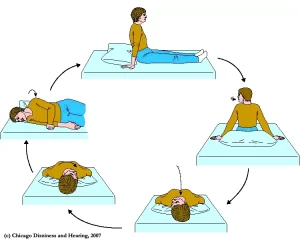
Marching in Place
- Place a chair in front of you and a wall behind you, much like in the Romberg exercise.
- If you start to fall, get help from the wall or chair.
- Spread your feet wide enough to be comfortable, as you normally would.
- Place your arms at your sides.
- Knees up toward the ceiling, enter a march.
- The step count should be increased progressively from 10 to 20 every session.
- Then return to your neutral position.
- Then relax.
- Repeat this exercise five to ten times.
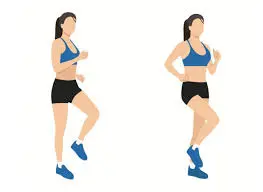
Romberg Stance
- Standing straight on the ground, take a few deep breaths.
- Maintain your feet by your sides at all times.
- A chair or a wall can be used as a hanger.
- Cover your eyes.
- Keep your head straight.
- Hold this posture for a few seconds.
- Tilt your head to the side as you open your eyes.
- Give it 10 or 15 seconds to get moving.
- Up and down head movements.
- Hold this position for a few seconds.
- Seal your eyes and go through the entire process again.
- Then return to your neutral position.
- Then relax.
- Repeat this exercise five to ten times.
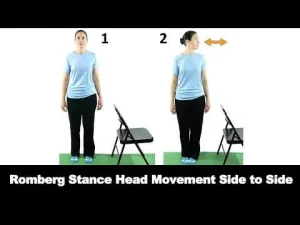
The Brandoff-Daroff exercise
- Take a seat in the middle of the bed with your feet flat on the ground.
- Make a head turn of 45 degrees.
- With your head still, lie down on your left side.
- Give it another 30 seconds or so until the dizziness stops occurring.
- If you are not dizzy, hold this position for a few seconds.
- Then return to your neutral position.
- Then relax.
- Return to your previous position.
- Get a 30-second relaxation.
- Move your head 45 degrees to the left side.
- In the right direction, repeat steps two and three.
- Hold this posture for a short while.
- Then return to your neutral position.
- Then relax.
- Repeat this exercise five to ten times.

Foster Maneuver
- Put your hands on the ground and knead.
- Rotate your head to and side.
- Wait until any dizziness goes away.
- Put your forehead on the ground and pull your chin toward your legs.
- Face your left elbow with a 45-degree head rotation.
- A pause of thirty seconds.
- Maintaining a 45-degree incline, raise your head until it is level with your shoulders and back.
- Again take a thirty-second pause.
- Lift your head till it is perfectly straight.
- Then return to your neutral position.
- Then relax.
- Repeat this exercise five to ten times.
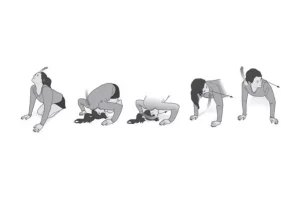
Gaze Stabilization
- Sit on a chair or table, or place yourself on a mat.
- Stretch one arm and your index finger outward.
- Concentrate on your index finger for 15 seconds.
- Turn your head slowly to the right and left while maintaining a fixed stare on your index finger’s tip.
- Do this again for ten seconds.
- Keep your eyes on the index finger and move your head up and down.
- For ten seconds, repeat.
- As you rotate your head up and down horizontally, keep your focus on the index finger.
- Do this again for ten seconds.
- Then return to your neutral position.
- Then relax.
- Repeat this exercise five to ten times.
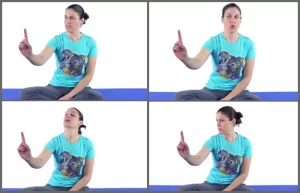
Forward Bend Seating
- Stretch your arms straight out to the sides and overhead to increase your reach toward the ceiling.
- Inhale as you extend your back.
- Breathe out and bend at the hips as you begin to lean forward.
- Expand your lower body with each breath.
- You may lean forward a little bit to achieve this.
- Expand your forward bend with each exhalation.
- Imagine that your belly is lying on your thighs, not your nose reaching your knees.
- You will be able to keep your spine long by doing this.
- Don’t let your neck fall too much or force it upward; instead, keep it as the natural extension of your spine.
- Once your spine has reached its greatest extension, decide whether to progress forward or stay in this position.
- Hold onto your ankles or legs, whatever is easiest to reach.
- Keep your feet strongly flexed the entire time.
- Then return to your neutral position.
- Then relax.
- Repeat this exercise five to ten times.

Diaphragmatic Breathing
- Either sit or lie flat on the floor in a comfortable position.
- Putting one hand on your chest and the other on your lower abdomen.
- Using your nose, inhale deeply and slowly.
- Take in as much air as you can to fill your stomach.
- As you take a breath, the hand on your tummy should rise.
- Breathe out slowly through your lips.
- Then return to your neutral position.
- Then relax.
- Repeat this exercise five to ten times.

Corpse Pose (Savasana) in Yoga
- Lay down on your back.
- Keep your legs apart.
- Give up attempting to maintain straight legs and let your feet fall freely to either side.
- Extend your arms to the sides, keeping them slightly apart from your body.
- When you flip your palms to face upward, don’t try to keep them open.
- Fold your fingers together.
- Shoulder blades are pulled into the back for stability.
- Once your limbs are in their proper positions, release the need to hold them there.
- Relax your face and your body as a whole.
- Let your limbs get stiff.
- Breathe naturally as it happens.
- If your brain becomes distracted, you can pay attention to your breathing, but try not to stress on it too much.
- Take at least half an hour to spend there. Ten minutes is better.
- Set an alarm to avoid being distracted by continually monitoring the time when training at home.
- Raise your arms upwards to fully extend your body from your hands to your feet.
- Roll to one side, bring your legs up to your chest and close your eyes.
- Use your lower arm as a pillow and lie in a fetal position.
- Use your hands to support yourself as you get back into a sitting position.
- Then return to your neutral position.
- Then relax.
- Repeat this exercise five to ten times.
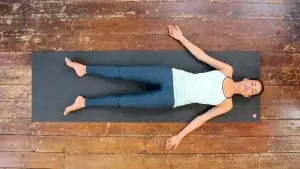
Which Exercises Should I Stay Away From If I’m Feeling Dizzy?
- To find out more about the kinds of exercises you may include in your workouts to improve your strength training, see a specialist.
- Additionally, give your neck a little, careful workout.
- Because sudden movements of the head might cause vertigo, it’s important to use caution when choosing helpful exercises.
- Vertigo may worsen with activities that involve large head movements, such as swimming.
- Your balance may be affected by calcium crystals in your ears forming considerably more quickly as a result of a nervous head.
When feeling vertigo, it is best to avoid certain types of exercise, like;
- Sit-ups
- A step up
- Lunges
When exercising, what precautions should someone who experiences vertigo take?
Any physical activity should be done very carefully when starting an exercise program to treat vertigo. Exercise-related vertigo may sometimes happen. In such situations, all you need to do is perform a movement and continue your workouts. Keep your head up even if you’re feeling dizzy.
Vertigo is a medical condition that includes a broad range of symptoms that may have multiple causes. Because the condition might differ from person to person, there will be a variety of treatment possibilities. Vertigo exercises are an option if you’d prefer to try a different kind of treatment.
- Place a chair or walker next to a wall or railing to help you maintain your balance, or get help from another source.
- Ask someone to stand close by while you work through these activities.
- Vertigo cannot be treated with exercise alone.
- Instead of it, place an anti-slip mat.
- Avoid making sudden head movements.
- To prevent slipping, dry off the flooring.
- Avoid rushing through these exercises as it could worsen your vertigo. Instead, proceed carefully and repeat each exercise multiple times.
- Maintain your practice to get better at what you do. Give yourself plenty of time.
- If you move gently, your chances of recovering from vertigo without hurting yourself are increased.
- Perform the steps properly and regularly. Check your development.
What is the natural method to get rid of vertigo?
Vertigo cannot usually be completely cured independently; a doctor must help. However, you might try the following natural solutions for reducing your symptoms;
- Move carefully when you stand up, turn around, or perform other trigger-triggering actions.
- Head up, and take a nap on two pillows.
- If you can, try lying in a calm, dark spot to alleviate the spinning feeling.
- Once you start feeling dizzy, sit down.
- Do simple exercises to relieve your stress.
- Instead of bending at the waist to pick something up, kneel.
- Spend a few minutes sitting on the edge of the bed before getting out of bed.
- Switch on the lighting if you awake in the middle of the night.
- Take part in vertigo-inducing activities to help your brain adjust and reduce the symptoms (but only when you’re sure you won’t fall and you have support if needed).
Conclusion
Those who are feeling lightheaded should consult with their doctor. Vertigo can happen suddenly and unexpectedly. Although vertigo is generally innocuous, it can make it difficult for a person to safely carry out everyday tasks, therefore a medical diagnosis is necessary.
Exercise can be a fast and effective way to relieve pain in addition to over-the-counter medications and home remedies. When seated or even standing unmoved, those suffering from vertigo may feel as though they are spinning.
Ear infections, irregular bone growth, middle ear calcium deposits, inflammation, and head trauma all worsen this illness. Vestibular rehabilitation treatment, head-elevated activities, proprioceptive/balance exercises, and eye-tracking exercises are some of the exercise therapies that can be used to manage this issue.
Sometimes vertigo resolves on its own. In other cases, a doctor may suggest medicine or alterations to lifestyle to help. In some situations, they might also suggest surgery.
FAQ
Is vertigo a serious medical condition?
Brain problems that produce central vertigo have been linked to serious conditions like stroke, brain tumors, and amyloid plaques. The instability in gait and a loss of coordination are possible signs. Usually, they begin small but continue over time.
How did I take care of my vertigo naturally?
A set of exercises called the Epley maneuver can be performed at home to cure vertigo. Drink lots of water, ginger tea, and vitamins containing ginkgo biloba. Alternatives are available if they prove to be ineffective. The spinning, lightheaded feeling known as vertigo can occur with or without movement.
What is the main cause of feeling dizzy?
An inner ear issue is frequently the root cause of vertigo. Among the most frequent causes is BPPV. Benign paroxysmal vertigo with these initials in place.
What is the duration of vertigo?
Vertigo episodes can last for a few seconds or several hours. Chronic dizziness could last for a few days or even months.
Does stress cause dizziness?
The hormones that are released by our bodies in response to stress, such as cortisol or adrenaline, can affect the inner ear, which is responsible for balance and orientation in space. Another concomitant physical manifestation of stress is vertigo.
Does vertigo impair vision?
Dizziness can cause dizziness and unsteadiness. Additional symptoms could include nausea, vomiting, and blurred vision. Feelings of nausea or nervousness may last for a short while even after the dizziness disappears.
Is dizziness a long-term illness?
Vertigo may be a temporary or chronic ailment for certain people. Chronic or prolonged vertigo may be more likely to affect those who have had a stroke, head trauma, or neck injuries in the past.
What calms dizziness down?
When experiencing vertigo, it can help to reduce the impression of spinning and relieve any nausea by lying still in a quiet, dark place. You may be advised to take medication. Additionally, you should try to avoid stressful situations as worry might aggravate vertigo symptoms.
Is walking beneficial for vertigo?
Walking is a straightforward but effective vertigo exercise. Better balance might be aided by it. Improved balance when walking can help you function more independently, which may increase your self-assurance. You will need to use your muscles when walking.
Does physical activity relieve vertigo?
Multiple research investigations have shown that adult individuals with persistent dizziness have improvements in their vertigo symptoms after completing exercise-based vestibular rehabilitation. These are the two exercises that your doctor will most likely recommend to you as part of your vestibular rehabilitation therapy.
How often should I practice exercises for vertigo?
The frequency of this treatment will be determined by the doctor you see. If your symptoms haven’t returned for a full day, he or she might tell you to do it three times a day. The source of your symptoms in the left or right ear will also be determined by your physician.
What are the early signs of vertigo?
Problems focusing on the eyes.
Hearing impairment in one or both ears.
Imbalance loss, which may result in ringing or falling ears.
Can vertigo appear and disappear?
Some persons have such severe symptoms that they interfere with their personal and professional lives. The symptoms usually disappear for a few weeks or months before returning. In the absence of treatment, symptoms may last a few weeks before improving. After the very first time, a tiny percentage of people never experience the symptoms again.
What makes you dizzy at night?
BPPV produces temporary, moderate to severe dizzy episodes. Usually, certain adjustments to your head’s position cause it to happen. When you lie down, tilt your head back or forth, or turn over or sit up in bed, this could happen.
Do experiences of vertigo affect your life?
Vertigo attacks can come on suddenly and fade away in a matter of seconds, or they may last far longer. Your symptoms could be ongoing and continue for several days if you have severe vertigo. Regular living may become challenging as a result.
Reference:
- Vertigo Home Remedies. 2, January 2017, 1. OnlineMD. Vertigo Home Remedies, 2017, https://www.webmd.com/brain/home-remedies-vertigo. In-text Citation:
- October 15, 2022, Ryt, A. P. How to Do Savasana, the Corpse Pose in Yoga, Verywell Fit. 10567112#toc-safety-and-precautions is the link to the corpse pose savasana on VeryWellFit.com.Reference within the text: Ryt, 2022
- As an expert, Treatment for Vestibular Rehab, C. C. M. n.d. Reference: Cleveland Clinic. (n.d.) https://my.clevelandclinic.org/health/treatments/15298-vestibular-rehabilitation
- A. B. P. Cht, Dpt, May 15, 2023. Vertigo Breathing Exercises. Verywell Medical. Breathing exercises for vertigo: https://www.verywellhealth.com/p/6266703. Citation inside text: (Cht, 2023)
- Conditions & ailments | NHS inform. 2023, October 23. taken from a pamphlet published by the NHS. causes of vertigo as well as treatment methods. Visit https://www.nhsinform.scot/conditions-and-illnesses/ears-nose-throat for more details about vertigo.
- 30 March 2023, Klopfer, R. 8 Exercises to Reduce Vertigo Symptoms. https://georgiauppercervical.com/vertigo-exercises/ is the website of Georgia Upper Cervical Chiropractic. Citation inside the text: Klopper, 2023
- 7 Simple Home Exercises for Vertigo (With Pictures).023, 30 August. STYLECRAZE. Available at https://www.stylecraze.com/articles/vertigo-exercises.In-text Citation: “7 At-Home Vertigo Exercises (With Pictures),” 2023)
- What Exercise Is for Vertigo, What Symptoms It Causes, and Who Should Avoid Exercise? Friday, November 6, 2023. Protection against figures. Reference within the text: https://www.godigit.com/health-insurance/exercise/exercise-for-vertigo According to “Exercise for Vertigo: Causes, Effects, and Who Should Avoid It, “2023,
- Image 1, BPPV using the Epley-CRP maneuver. (n.d.). Dizziness and balance (online): Disorders/BPPV/Epley/Epley.html
- Image 2, Marching in Place: A Balance-Improving Exercise NYP, n.d. Presbyterian of New York. A marching-in-place exercise to improve balance can be found at https://www.nyp.org/healthlibrary/multimedia.
- Image 3, A. July 16th, 2017. Ask Dr. Jo about the Romberg Stance Head Movement Side to Side. YouTube. Watch this video at https://www.youtube.com/watch?v=Lgg0fPvKsgM
- Image 4, To view, sign up, or log in. (As of now). The photo titled “A.102642444842197/270290544744052” is available at https://www.facebook.com/relievephysicaltherapy/?type=3.
- Image 5, Exercise For Vertigo: Simple Ideas For Immediate Recovery. April 15, 2021. The Regency Medical Center. www.regencymedicalcentre.com/blog/easy-tips-for-quick-relief-exercise-for-vertigo/
- Image 6, March 8, 2024: Biswas, C. Here are 7 at-home vertigo exercises (with pictures). Vertigo exercises: STYLECRAZE. https://www.stylecraze.com/articles/
- Image 7, March 8, 2024: Biswas, C. Here are 7 at-home vertigo exercises (with pictures). Vertigo exercises: STYLECRAZE. https://www.stylecraze.com/articles/
- Image 9, A. on July 13, 2020. SHAVASANA (Corpse Pose): Conquer, triumphantly. Shavasana’s Corpse Pose [Conquerpcos, 2016]








2 Comments